Windows 11/10 offers the option to display certain messages during its startup and shutdown. These are referred to as Verbose Status Messages and tell us the processes or steps that the Windows operating system is taking during startup, shutdown, logon, and logoff operations. These verbose messages tell you what Windows does in the background while carrying out these operations.
You may have seen such messages when your Windows starts or shuts down. These are Verbose Status Messages.

Verbose status messages can be very helpful when debugging or troubleshooting certain Windows problems, including slow startup, shutdown, logon, or logoff behavior. If your Windows is just not shutting down, verbose status messages may tell you where exactly or at which stage it is getting ‘stuck’.
There are some regular messages you will always see even when verbose messages are not enabled, like Applying your personal settings or Applying computer settings. But when you enable verbose status messages, you will see additional status messages which will help you while debugging or troubleshooting.
The Verbose Messages you may see during startup could include:
- Starting Windows
- Starting Group Policy Service
- RPCSS is starting
- Starting Windows Update Service
- Applying your personal settings
- Applying computer settings
- Please wait for the User profile to load
- Preparing your Desktop
During the shutdown you would probably see messages like:
- Shutting down “application”
- Stopping Group Policy Service
- Stopping Windows Update
- Please wait for Group Policy Service
- Please wait for Windows Update Service
- Notifying services that Windows is shutting down
- Waiting for machine group policies to finish
- Stopping Services
- Shutting Down
- Windows is preparing to shut down the computer.
Enable Verbose or Highly Detailed Status Messages in Windows 11
If you wish, you can enable or disable the verbose status messages by using the Group Policy Object Editor, editing the Windows Registry, or using Ultimate Windows Tweaker.
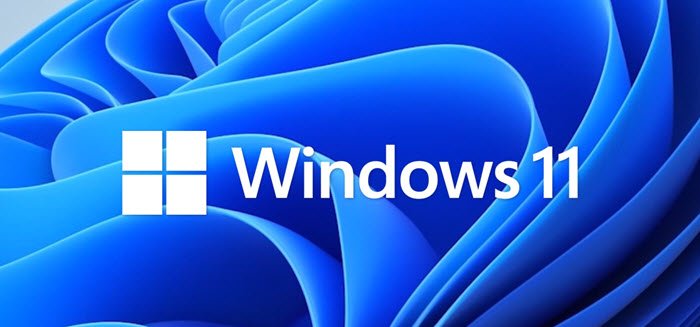
Enable Highly Detailed Status Messages using Group Policy
In Windows 11/10
If your edition of Windows has the Group Policy Editor, you can type gpedit.msc in start search and hit Enter.
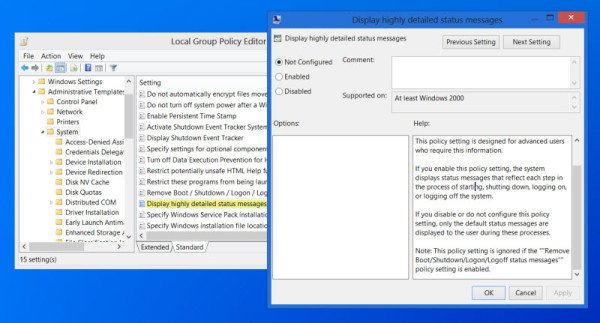
Navigate to Computer Configuration > Administrative Templates > System. Now in the right pane, double-click on Display highly detailed status messages. This setting is designed for sophisticated users that require this information and directs the system to display highly detailed status messages.
If you enable this setting, the system displays status messages that reflect each step in the process of starting, shutting down, logging on, or logging off the system. Do note that if the “Remove Boot / Shutdown / Logon / Logoff status messages” setting is enabled, this setting will be ignored.
This policy setting directs the system to display highly detailed status messages. This policy setting is designed for advanced users who require this information. If you enable this policy setting, the system displays status messages that reflect each step in the process of starting, shutting down, logging on, or logging off the system. If you disable or do not configure this policy setting, only the default status messages are displayed to the user during these processes. Note: This policy setting is ignored if the “Remove Boot/Shutdown/Logon/Logoff status messages” policy setting is enabled.
Thanks for pointing out the change in the name 3ICE.
In Windows 7
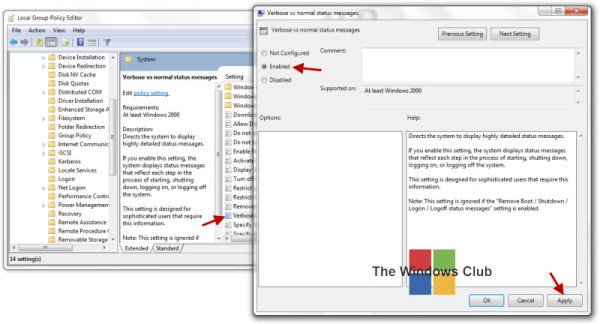
In Windows 7 this setting is called Verbose vs normal status messages.
Enable Verbose Messages editing Registry
If your Windows edition does not have the Group Policy Editor, you may enable verbose status messages by editing the Windows Registry. To do so, type regedit in start search and hit Enter. Now navigate to the following registry key:
HKEY_LOCAL_MACHINE\SOFTWARE\Microsoft\Windows\CurrentVersion\Policies\System
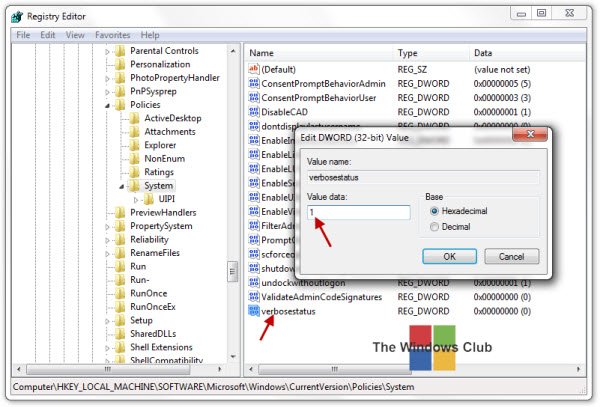
Now right-click in the right pane and create a new New, DWORD Value verbosestatus. Give it a value 1. This will enable Verbose Status Messages.
To disable these messages give it a value 0 or simply delete the created key. Exit Registry.
Enable Verbose Status Messages quickly using Ultimate Windows Tweaker
If you don’t want to get into all this, simply download and use our freeware Ultimate Windows Tweaker. This tool will let you enable or disable Verbose Status Messages with a click.
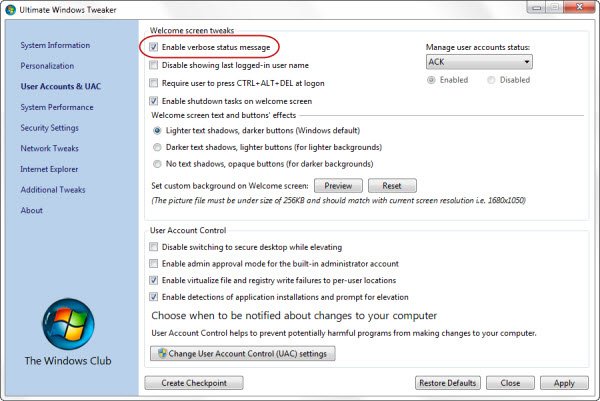
The setting is under the User Accounts and UAC tab. You can download it by clicking here.
Once again, Windows will not display the verbose status messages if there exists this key and its value is set to 1:
HKEY_LOCAL_MACHINE\SOFTWARE\Microsoft\Windows\CurrentVersion\Policies\System\DisableStatusMessages
Enabling Verbose Status Messages may increase your startup and shutdown times, so you may not want to have this setting enabled permanently.
You may want to read this post if your Windows does not shut down.
Also, check out how to enable the Shutdown Event Tracker.